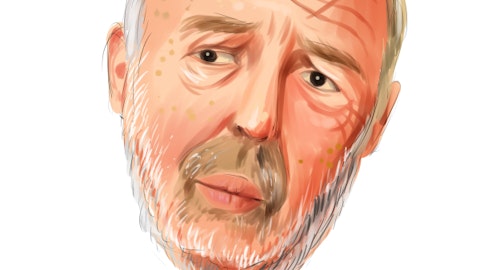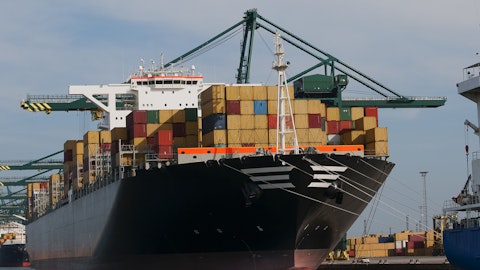David Grzebinski: Yes. No, inflation is — it’s still here as I think most of us feel. What I would tell you on inflation is we haven’t seen grow any further. But look, when we look at food for our marine crews, those prices are up 10%, but they haven’t gone further up. But it’s still a lot higher than we’ve traditionally had. If you look at crew transportation, whether it’s rental cars or airline flights, those costs are up significantly from, kind of, the norms anything electronic-related, for example, radars or things on our boats are still up. What I would say, maybe we didn’t state this right in our prepared remarks, but inflation hasn’t come down, but it hasn’t grown any further. So we like to say that’s abating, but we haven’t really seen prices contract, we’ve just seen them not go up as much as they were kind of flattish from where they were last quarter.
So that helps. Obviously, we’ve needed price increases just to keep up with inflation. If inflation stays in check and doesn’t grow anymore, that obviously would help our margin profile and kind of get to where we talked about in our prepared remarks in terms of the end of the year. Now if inflation goes up further, that’s going to obviously have an adverse effect to margins. But right now we feel pretty good that things are kind of flattening out. Obviously, the Fed will see what they do today and it’s being very aggressive to tame inflation. So that’s good and bad. Obviously, we hope it doesn’t trip us into a recession.
Nathan Ho: I see. And just to clarify, on the margin targets set for 2023 across the segments, that’s baking in sort of a flattish cost structure into this year? Would that be correct?
David Grzebinski: Yes, flattish in terms of general inflationary. I think, obviously, we’re going to have crew labor costs go up. I think everybody is seeing labor costs continue to rise. But that obviously is going to happen. We factored a little bit of that in. If it gets acute, that we’d have some headwinds. But right now, we’ve factored in a little labor inflation. But the rest of the inflationary pressures we think will just kind of stay where they are at. We don’t anticipate any sharp price increases across most of our supply chain.
Nathan Ho: Great. And just as a follow-up on the capital strategy into 2023. I’m aware that the CapEx plan is still on the works. But in terms of capital deployment, are there any updates on how the company is seeing M&A into 2023? How are you viewing, say, the availability of opportunities here?
David Grzebinski: Yes. is there are opportunities out there. It’s best for us not to comment on any of those, but look, there are opportunities out there. But I would tell you, look, we’ve had a history and we always like to consolidate particularly our Inland tank large market. That said, I feel strongly and the Board does too, the best barge company to buy right now is Kirby. When we look at our prospects in marine and in our distribution business, it’s about as good as we’ve seen in the long while. So we’re quite excited and we believe that it’s going to be multi-years. It’s not just a one year, kind of, phenomena. So when we look at capital deployment for acquisitions, we’re factoring in Kirby looks pretty good right now.
Nathan Ho: Got it. Thanks again for the time.
Operator: Please standby for our next question. Our next question comes from Greg Lewis with BTIG. Your line is now open.
Greg Lewis: Yes. Hi, thank you and good morning, everybody, and thanks for taking my question. Definitely good to see as is starting to find its groove. I did want to touch a little bit on kind of the, I guess, ongoing dynamics in that market and a lot of us to follow the refinery products industry or looking at that Russian oil embargo on products that’s coming out in February and some of the challenges are that, kind of, the refining industry might have to face or actually more of an opportunity than challenges, I guess. But as we think about that coming next month, is there any way we can think about or how are you thinking about potential changes in activity feedstock? We’re hearing a lot about, obviously, it’s going to be problems with DGO. What type of setup does that should we think about that creating in the first part of this year?
David Grzebinski: Yes. Let’s break it into a few of our trade lines. I don’t want to get too specific for obvious reasons with competitors and customers. But look, the refinery complex is really strong right now. Demand for refinery type — refined product moves is very, very strong right now. Probably the strongest we’ve ever seen in. Yes, I think a lot of that is kind of reopening, we’re also seeing export volumes look pretty good. So look, the refiners had great cracks spreads and they’re pulling back a little bit, but they’re still in terms of traditional crack spreads are still pretty strong. And the refinery complex in the U.S. is probably the most efficient in the world. I think refineries in Europe, that’s a home another situation.
And then if you pivot to chemicals, it’s really more the same, right? The chemical complex in Europe obviously, the natural gas price is high and energy price is high, it’s really suffering the U.S. position in chemicals one, you’ve got brand new plants or very efficient plants that were recently built in the last four, five years. Good feedstock position. So chemicals though did pull off a little bit in the fourth quarter. They’ve been coming back slowly here so far in the first quarter. It’s a little early to say how far that’s going to go. Obviously, when you listen to the Chemical Company’s earnings calls, Europe is hurting him a little bit on housing starts, hurting a little bit as well. But so far, it feels pretty good and things are — the volumes and pulled off enough to really impact our demand and supply picture.
When you look at black oil and other things that’s pretty strong. I will tell you we talked about the maintenance bubble that’s hitting the industry. I would tell you it’s more acute in black oil than it is and anything else. There’s a huge number of black oil barges that are going to have to be maintained across the industry in 2023 and 2024. But demand seems to be holding up in black oil. And then if you look at Ag products, that’s been pretty strong as well. So we look at each of those trade lanes and have been very encouraged by the demand picture. Now that said and you heard it in my cautionary comments about the potential recession. I mean, it could come, it could pull back a little bit. But right now, when we look at the demand side of things and the supply, it’s still really positive for us, Greg.
Greg Lewis: Okay. That’s great to hear. And then you did touch a little bit on pet chems, you know, I guess Q1 is seasonally the weak quarter for you. I guess maybe given the fact that we’ve seen, I guess what natural gas price is down 30% year-to-date, could that kind of collapse in natural gas prices maybe help Q1 be a little less weak just given the fact that as a pet chem plant, that’s got to be — we have must be in a very — much more profitable environment than we were, say, six to eight weeks ago?
David Grzebinski: Yes. Look, you’re right, our first quarter is almost always our weakest quarter of any year and that’s really weather related. It’s one thing with low water, but fog just really shuts us down on the Gulf Coast through the first quarter a lot, and then we get impacted. So that’s part of the weakness. But to your point, I think natural gas prices being a little lower, certainly is going to help the chemical complex be a little more profitable, which should help volumes a bit. And then I think at some point we’re going to see China open back up and China is a big consumer of chemicals as you know. The other interesting thing that Venezuelan crude for example imports — that’s positive. It gets a heavier fruit slate into the Gulf Coast that has more byproducts as you know.
That really helped the entire barge complex just all the different derivatives that can come from a heavy crude slate. So maybe that helps a little bit in the first quarter. But look, first quarter, as you know, it’s been our weaker quarter of the year. But again, the overall supply demand picture for us in 2023 is very robust. And we’re pretty excited about what we see in front of us, Greg.
Greg Lewis: Okay, great. Thank you, very much, and nice job on the quarter guys. Thanks. Have a great day.
David Grzebinski: Thanks, Greg.
Operator: Please standby for our next question. Our next question comes from Greg Wasikowski with Webber Research. Your line is now open.
Greg Wasikowski: Hey, David and Raj. How are you doing?
David Grzebinski: Good.
Raj Kumar: Good morning, Greg.
Greg Wasikowski: Yes, thanks. Thanks for taking the questions. First one, David, curious if you — can you just talk about what you’ve seen with rate movements so far? Or through Q4 and so far into Q1? I know, it’s a smaller sample size. But from what we’ve seen, there’s been maybe a little bit of plateau in that period. So could you comment on that? And then if you revisit your thoughts around the pace of the recovery versus the overall sustainability of the recovery of that relationship, where we were towards the back end of 2022 versus how 2023 is shaping up from a sustainability perspective, it would be great?
David Grzebinski: Sure. Sure, Greg. Look, in our prepared remarks, probably heard some of this, but sequentially, we saw spot rates up mid-single-digits. That was off of a very strong third quarter. So fourth quarter sequentially was still up mid-single-digits on spot. Contract — well, and then if you look at spot year-over-year, it’s still up 20%-plus from a year-over-year on spot. Term contracts were up double-digits, which that’s on a year-over-year basis, which is pretty strong. I would tell you we’re still seeing a good pricing environment. It’s still very tight and prices are still rising. Really haven’t filled of plateauing. Maybe some of the market checks are seeing that, but we’re not. It’s still very, very strong.
And it needs to be. I mean, it’s — we’ve talked about inflationary pressures, but we’ve got a situation where we’re still a long way away from being — having rates to build replacement capacity. So we need to continue with a good price momentum. And given as tight as we’re seeing it in terms of supply and demand. We’re not seeing a pullback in rates at all. And again, I talked a little bit about the maintenance cycle that the industry is going to see. It’s going to have a profound impact too, it’s — profound is probably too strong at work, but it’s certainly going to add some momentum to this. So that’s a long way of saying, again, we’re pretty optimistic you can’t get noise in the winter months. I’ll just say that, so maybe I don’t know what your market checks are telling you, but sometimes you hear some noise in the winter months.
But again, we’re very positive, Greg.





